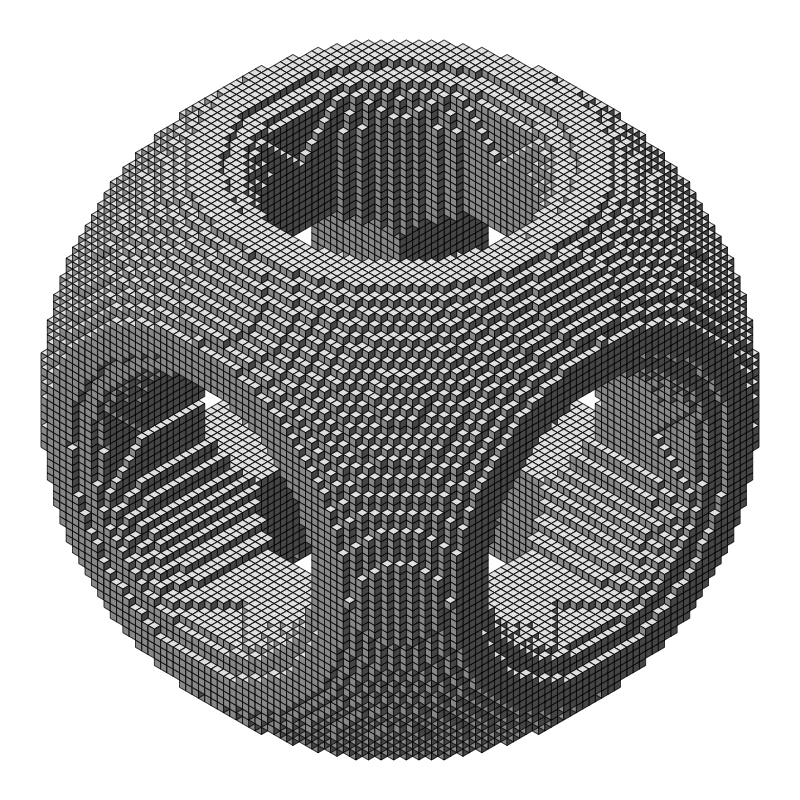isocubes 
The purpose of this package is to provide a 3D rendering backend for a very particular visual aesthetic.
That is, {isocubes} is an isometric rendering canvas with cubes as the only graphics primitive.
Some tools are included for creating particular scenes, but in general, if you can provide a list of (x,y,z) integer coorindates of what to render, then isocumes will create a 3d render.
What’s new in v0.1.2
- Signed distance fields for creating objects
Installation
You can install from GitHub with:
# install.package('remotes')
remotes::install_github('coolbutuseless/isocubes')Fake Terrain with ambient
library(grid)
library(ggplot2)
library(dplyr)
library(ambient)
#~~~~~~~~~~~~~~~~~~~~~~~~~~~~~~~~~~~~~~~~~~~~~~~~~~~~~~~~~~~~~~~~~~~~~~~~~~~~
# Create some perline noise on an NxN grid
#~~~~~~~~~~~~~~~~~~~~~~~~~~~~~~~~~~~~~~~~~~~~~~~~~~~~~~~~~~~~~~~~~~~~~~~~~~~~
set.seed(3)
N <- 60
dat <- long_grid(x = seq(0, 10, length.out = N), y = seq(0, 10, length.out = N)) %>%
mutate(
noise =
gen_perlin(x, y, frequency = 0.3) +
gen_perlin(x, y, frequency = 2) / 10
)
hm <- dat %>%
mutate(
x = x * 4,
z = y * 4,
y = noise * 4
)
pal <- topo.colors(11)
sy <- as.integer(10 * (hm$y - min(hm$y)) / diff(range(hm$y))) + 1
cols <- pal[sy]
cubes <- isocubesGrob(hm, ysize = 1/45, xo = 0.7, fill = cols, col = NA)
grid.newpage(); grid.draw(cubes)
Bitmap font rendering
library(grid)
library(isocubes)
library(bdftools)
bdf <- bdftools::read_bdf_builtin("spleen-32x64.bdf")
single_word <- bdftools::bdf_create_df(bdf, "#RStats!")
N <- 10
cols <- rainbow(N)
multiple_words <- purrr::map_dfr(seq(N), function(i) {
single_word$z <- i
single_word$col <- cols[i]
single_word
})
cubes <- isocubesGrob(multiple_words, ysize = 1/170, xo = 0.1, fill = multiple_words$col)
grid.newpage(); grid.draw(cubes)
Signed Distance Fields - Simple
library(grid)
library(dplyr)
library(isocubes)
# Create a scene that consists of a scaled torus
scene <- sdf_torus(3, 1) %>%
sdf_scale(5)
# Render the scene into a list of coordinates of voxels inside objects
coords <- sdf_render(scene, N = 30)
# Create cubes, and draw
cubes <- isocubesGrob(coords, ysize = 1/50, xo = 0.5, yo = 0.5, fill = 'lightblue')
grid.newpage(); grid.draw(cubes)
Signed Distance Fields - More Complex
library(dplyr)
library(grid)
library(isocubes)
sphere <- sdf_sphere() %>%
sdf_scale(40)
box <- sdf_box() %>%
sdf_scale(32)
cyl <- sdf_cyl() %>%
sdf_scale(16)
scene <- sdf_subtract_smooth(
sdf_intersect(box, sphere),
sdf_union(
cyl,
sdf_rotatey(cyl, pi/2),
sdf_rotatex(cyl, pi/2)
)
)
coords <- sdf_render(scene, 50)
cubes <- isocubesGrob(coords, ysize = 1/100, xo = 0.5, yo = 0.5, fill = 'lightseagreen')
grid.newpage(); grid.draw(cubes)
Signed Distance Fields - Animated
Unfortunately this isn’t fast enough to animate in realtime, so I’ve stitched together individuall saved frames to create an animation.
thetas <- seq(0, pi, length.out = 45)
for (i in seq_along(thetas)) {
cat('.')
theta <- thetas[i]
rot_scene <- scene %>%
sdf_rotatey(theta) %>%
sdf_rotatex(theta * 2) %>%
sdf_rotatez(theta / 2)
coords <- sdf_render(rot_scene, 50)
cubes <- isocubesGrob(coords, ysize = 1/110, xo = 0.5, yo = 0.5)
png_filename <- sprintf("working/anim/%03i.png", i)
png(png_filename, width = 800, height = 800)
grid.draw(cubes)
dev.off()
}
# ffmpeg -y -framerate 20 -pattern_type glob -i 'anim/*.png' -c:v libx264 -pix_fmt yuv420p -s 800x800 'anim.mp4'
Technical Bits
Cube occlusion
In an isometric view, a cube at position (x, y, z) will block the view
of any cube at (x + n, y - n, z + n).
Since cube positions must be integer values, hashes of cube positions are
calculated as x + (y * 256) + (z * 256^2).
For each initial cube position, calculate the hash or coordinates of several occluded cubes. Then remove any initial cubes which match the occluded cube hashes.
Cube sort
Arrange cubes by -x, -z then y to ensure cubes are drawn in the correct
ordering such that cubes in front are drawn over the top of cubes which
are behind.
grob
All the faces of all the cubes are then calculated as polygons - each with 4 vertices.
The data for all polygons is then concatenated into a single polygonGrob()
call with an appropiate vector for id.lengths to split the data.
Prototyping
Most of the prototyping for this package was done with {ingrid} -
a package I wrote which I find makes working iteratively/at-the-console with base grid graphics
a bit easier.
Acknowledgements
- R Core for developing and maintaining the language.
- CRAN maintainers, for patiently shepherding packages onto CRAN and maintaining the repository
